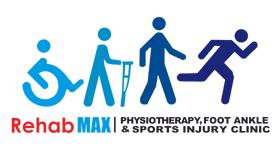Recovery after surgery with post-operative physiotherapy in the hospital and at Home
For recovering after surgery, physiotherapy is an integral part of treatment for patients who are or have been hospitalized, as prolonged immobilization puts patients at risk for complications such as deconditioning, muscle weakness, myopathy and neuropathy, respiratory infections, and contractures. It is important for such patients to consider physiotherapy at home as an integral part of the process of recovery after surgery.
The main aim of a physiotherapist is to assist your return to normal activities of daily living after hospitalization. Physiotherapists typically help with many aspects of your treatment while in the intensive care unit (ICU) and will continue working with you when you transfer to a general ward until you leave the hospital to go home. Even at home, in many cases, a physiotherapy home care program can significantly aid the recovery of the patient. RehabMax Physiotherapy’s home care program is designed and our physiotherapists understand the requirements for post-surgical/ post ICU patients
Our home visit physiotherapist will assess and treat :
- neurological,
- musculoskeletal and
- cardiorespiratory complications of the patients and help them in recovery.
- The physiotherapist is involved in specific patient positioning, suctioning, mobilization, ambulation, strengthening and balance exercises, passive range of motion exercises, and airway clearance techniques.
Benefits of physiotherapy in hospital for recovery after surgery:
- Enables the patients to recover from the episodes of the hospital as early as possible
- Prevent post-op complications
- Teach the patient how to manage their own recovery post-discharge
- Facilitate safe and early discharge by reducing the length of stay in the hospital
- Improves the quality of life
Physiotherapy helps in:
- Improve the cardiovascular endurance
- Improved performance of daily tasks
- Improves the strength and endurance of the muscles
- Improves the lung capacity
- Makes the patient mobile and independent
- Improves the airway clearance
- Early mobilization of ventilated patients by a physiotherapist reduces mortality and results in improved physical function and mobility
- Physiotherapy post-surgery:
The main aim of post-operative physiotherapy is to return to normal activities as early as possible.
Routine post-operative physiotherapy intervention comprises breathing exercises, circulatory exercises, and early mobilization to prevent complications and education in home management, cardiovascular fitness, limiting restrictions due to medical procedures, and many others as listed underneath.
A. Positioning:
To prevent complications like bedsores, congestion in the lungs, change of positions after regular intervals become important.
B. Chest PT:
Breathing exercises are important for the patient to reduce chest infections and improve air entry in the lungs. It also helps complete the expansion of the thorax in order to have effective breathing. Breathing exercises include deep breathing exercises, segmental breathing exercises, thoracic expansion exercises, pursed-lip breathing exercises and active cycle of breathing techniques.
Coughing huffing techniques where the patient is taught how to do forceful expiration by supporting the wound to get rid of the accumulated sputum actively
Airway clearance: physiotherapists help to clear the excess sputum by different techniques like positioning the patient, postural drainage, suctioning, and use of different expiratory devices
C. Limb PT:
It is important to maintain blood circulation following surgery to reduce the risk of deep vein thrombosis due to immobility. Hence mobility exercises are important.
Also, it helps to improve and maintain joint mobility and muscle strength which eventually gets deconditioned due to illness
D. Mobilisation:
Early mobilization is a key factor in reducing post-operative complications, enabling a quick recovery and timely discharge from the hospital. The patient is assisted to get out of bed by the physiotherapist on the day of your operation or the following day depending upon the type of surgery. The final goal is to increase patients’ mobility making them independent and training stair climbing if required.
The above-mentioned post-operative physiotherapy treatment principles were the general ones. But the treatment differs in different surgeries viz; orthopedic surgeries, abdominal surgeries, cardiothoracic surgeries, vascular surgeries, neurosurgeries.
Benefits of physiotherapy at home for recovery after surgery:
To determine the treatment needs of the patient after surgery once they have been discharged to recover at home, the physiotherapist assesses the patient’s physical function including:
- Pain, swelling, joint range of motion, muscle strength, muscle coordination, mobility status, balance, respiratory status, and cardiovascular fitness in ortho surgeries
- Pain, discrepancies in balance, coordination, muscle weakness and fatigue, work of breathing, and loss of range of movement, loss of cardiovascular fitness and mobility status in abdominal and cardiovascular surgeries
- Pain, muscle tone, consciousness, orientation, work of breathing, balance and coordination, sitting and standing ability, synergy patterns, gait in neurosurgeries.



